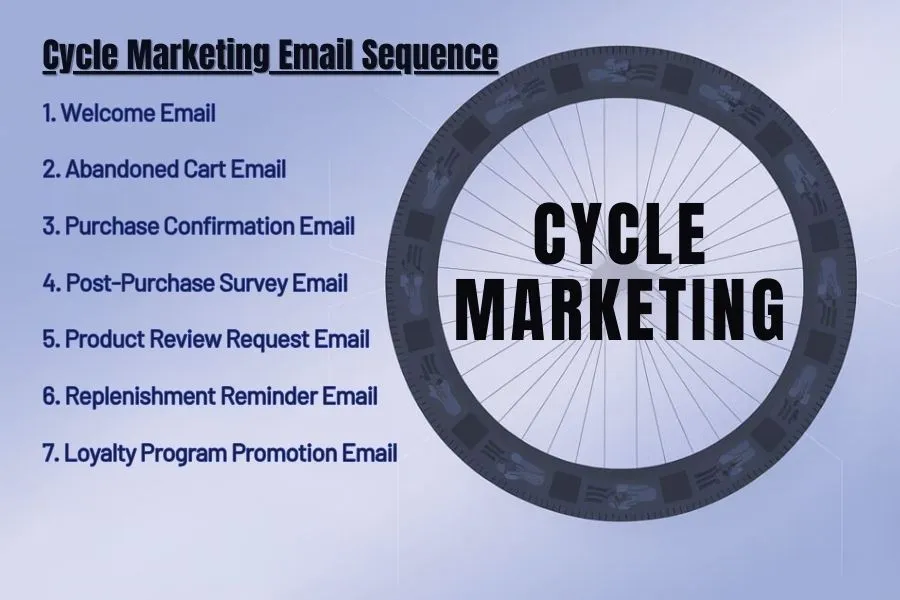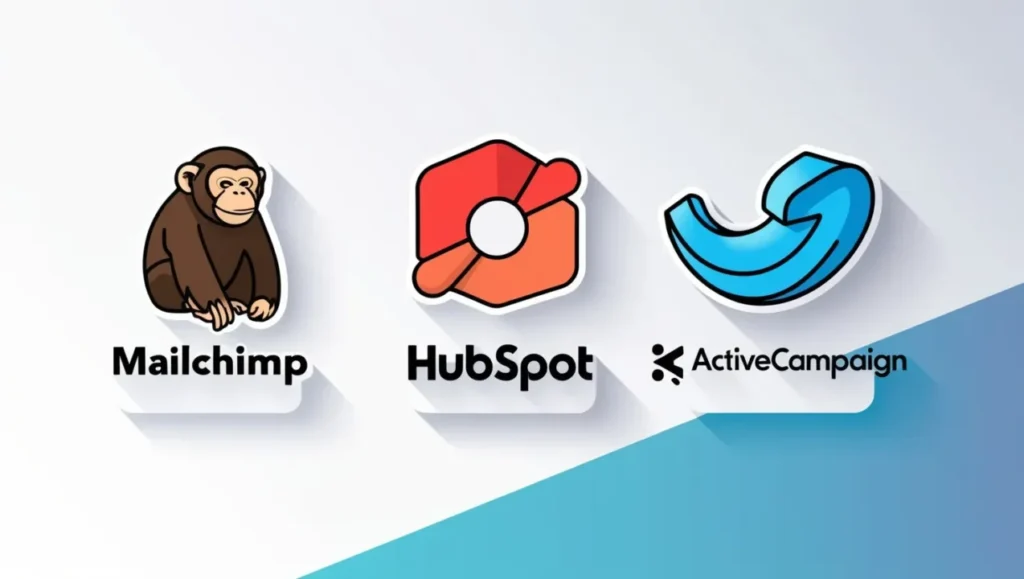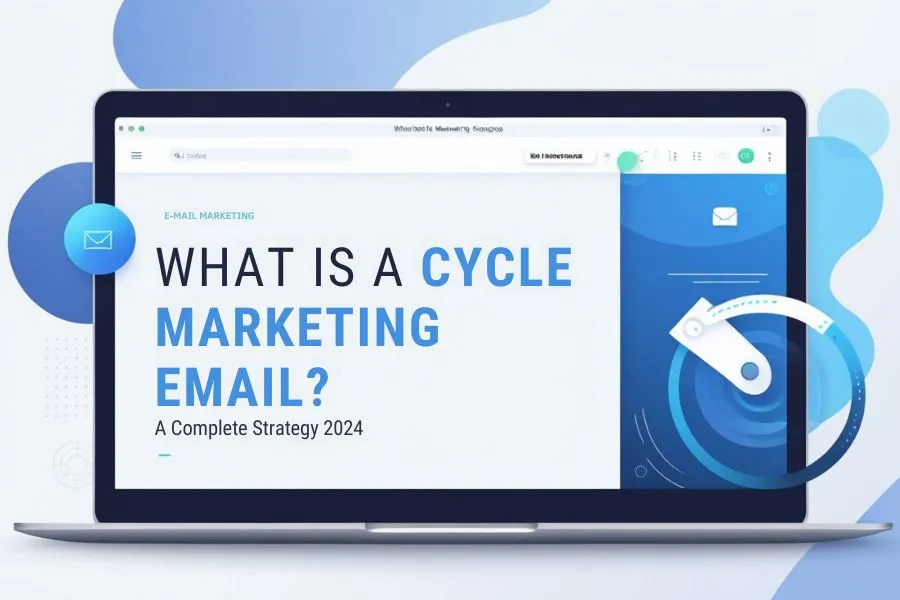Table of Contents
Email marketing is more essential than ever, not just email marketing. To stand out, businesses need to engage audiences with thoughtful, timely, and personalized messages. Enter Cycle Marketing Emails, a strategy designed to lead your audience through each step of their customer journey. By understanding “What Is a Cycle Marketing Email” and how it works, you’ll be better equipped to nurture relationships and maximize engagement.
What Is a Cycle Marketing Email?
A Cycle Marketing Email is a targeted, automated email sent at specific stages of the customer journey to support a seamless interaction with your brand. Unlike general email marketing campaigns, these emails follow a “cycle,” guiding customers from initial awareness all the way to long-term loyalty.
Example Cycle Marketing Email Sequence

Let’s consider a fictional online store selling fitness equipment:
- Welcome Email: Sent immediately after sign-up or purchase.
- Content: Welcomes the new customer, provides essential information (e.g., order details, return policy), and offers a discount code for their next purchase.
- Abandoned Cart Email: Sent when a customer adds a product to their cart but doesn’t complete the purchase.
- Content: Reminds the customer about the abandoned items, highlights the benefits of the products, and includes a link to the cart.
- Purchase Confirmation Email: Sent after a successful purchase.
- Content: Confirms the order details, provides tracking information, and suggests related products or accessories.
- Post-Purchase Survey Email: Sent a few days after the purchase.
- Content: Requests feedback on the customer’s experience, asks about product satisfaction, and offers incentives for completing the survey.
- Product Review Request Email: Sent a week after the purchase.
- Content: Encourages the customer to write a product review and offers a discount or giveaway for doing so.
- Replenishment Reminder Email: Sent periodically based on the customer’s purchase history.
- Content: Suggests that it’s time to reorder a previously purchased product and provides a link to the product page.
- Loyalty Program Promotion Email: Sent to reward loyal customers.
- Content: Highlights the benefits of the loyalty program, such as exclusive discounts, early access to new products, or personalized offers.
How Cycle Marketing Emails Work
The Cycle Email Strategy operates through four distinct phases:
- Awareness Phase: This initial stage introduces potential customers to your brand. Emails might offer helpful content or a lead magnet to capture attention.
- Consideration Phase: Here, you provide information that helps recipients evaluate your products or services, like case studies or testimonials.
- Decision Phase: At this stage, the email should focus on conversion by offering discounts, free trials, or demos to nudge the recipient towards a decision.
- Retention Phase: Post-purchase emails keep the customer engaged. This can include follow-ups, feedback requests, or loyalty offers.
Timing is essential. A successful Email Marketing Cycle relies on sending each email at the right point in the customer journey.
Benefits of a Cycle Marketing Email Strategy
- Enhanced Customer Engagement: Regularly engaging customers keeps your brand top of mind.
- Improved Conversion Rates: Personalized emails, tailored to each stage, lead to higher conversion rates.
- Building Long-Term Relationships: Cycle emails nurture loyalty by continuously adding value and addressing customer needs.
How to Build an Effective Cycle Marketing Email Strategy
Ready to get started? Here’s a step-by-step guide to building a cycle email strategy:
- Define Your Goals: Identify what you hope to achieve with your Automated Cycle Marketing—whether it’s increased sales, engagement, or customer retention.
Example: If your goal is to increase sales, you might focus on emails that promote special offers or limited-time discounts.
- Understand Your Audience: Research your audience to determine their interests and buying behaviors.
Example: If you’re targeting a younger audience, you might use more casual language and incorporate visuals.
- Design Targeted Emails: Create relevant content for each phase of the cycle that will resonate with your audience.
Example: For a welcome email, you might offer a discount code and a link to a helpful resource. For an abandoned cart email, you could remind the customer about the items they left behind and include a call to action to complete their purchase.
- Set Up Automation: Use tools like HubSpot to automate email sending, based on behavioral triggers and specific timings.
Example: Using a tool like HubSpot, you could set up an automated email sequence that sends a welcome email to new subscribers, followed by a series of promotional emails and product recommendations.
Best Practices for Cycle Marketing Emails
To get maximum results, keep these following tips in mind:
- Personalization and Customization: Address subscribers by name and tailor content to their preferences.
Example: “Hi [Person Name], We check you recently check the [Product Name]. Check out this [Offer Code] for a limited time!”
URL: [Your Website]
- Creating a Clear Call-to-Action (CTA): Each email should have a distinct CTA that aligns with the cycle phase.
Example: “Shop Now and Save 20%!” or “Book a Test Ride Today”
URL: [Your Website]
- A/B Testing for Optimal Performance: Test different subject lines, visuals, and CTAs to find what works best.
Example: Test subject lines like “New Arrivals: Explore Our Latest Bikes” vs. “Don’t Miss Out: Exclusive Bike Sale!”
URL: [Your Website]
Top Tools for Cycle Marketing Email Automation

- Mailchimp: Known for its user-friendly interface, Mailchimp offers customizable automation for the email cycle.
- HubSpot: HubSpot provides powerful automation features and integrations with CRMs.
- ActiveCampaign: This tool combines email marketing with CRM functionalities, ideal for managing the entire customer journey.
Conclusion
To sum up, Cycle Marketing Emails are a powerful way to connect with customers throughout their journey. By delivering the right message at the right time, businesses can build lasting relationships and drive meaningful engagement. The future holds exciting advancements with AI and multi-channel integration, making cycle emails even more effective.
FAQs
1. What Is a Cycle Marketing Email?
A Cycle Marketing Email is a targeted, automated email sent at different stages of the customer journey to support and nurture their relationship with the brand.
2. How Does Cycle Email Strategy Improve Engagement?
By delivering relevant content at each stage, it keeps customers interested and aligned with their needs, resulting in better engagement.
3. What Are the Best Tools for Automated Cycle Marketing?
Tools like Mailchimp, HubSpot, and ActiveCampaign offer automation features tailored for Cycle Marketing Emails.
4. How Often Should I Send Emails in the Marketing Cycle?
Frequency depends on your audience and campaign, but avoid overwhelming them. Aim for a balanced approach based on the customer journey stage.
5. Can Cycle Marketing Work for Small Businesses?
Absolutely! Cycle marketing emails help small businesses connect with customers effectively, building loyalty and increasing conversions.

